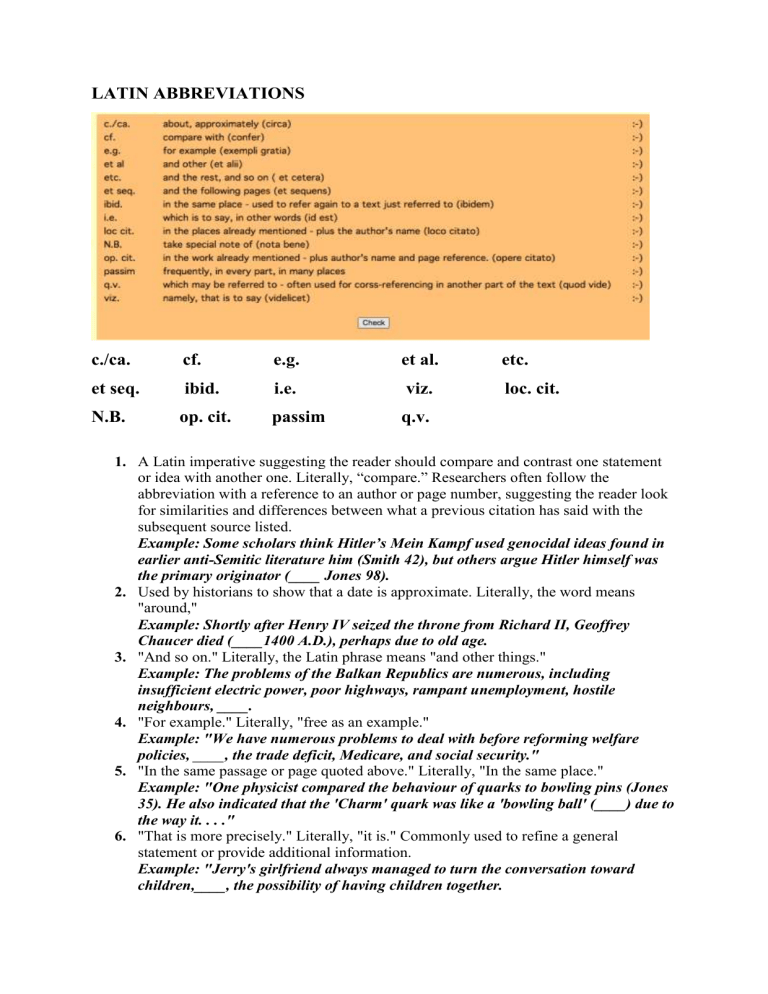Uploaded by
common.user7867
Latin Abbreviations: A Quick Reference Guide

LATIN ABBREVIATIONS c./ca. cf. e.g. et al. etc. et seq. ibid. i.e. viz. loc. cit. N.B. op. cit. passim q.v. 1. A Latin imperative suggesting the reader should compare and contrast one statement or idea with another one. Literally, “compare.” Researchers often follow the abbreviation with a reference to an author or page number, suggesting the reader look for similarities and differences between what a previous citation has said with the subsequent source listed. Example: Some scholars think Hitler’s Mein Kampf used genocidal ideas found in earlier anti-Semitic literature him (Smith 42), but others argue Hitler himself was the primary originator (____ Jones 98). 2. Used by historians to show that a date is approximate. Literally, the word means "around," Example: Shortly after Henry IV seized the throne from Richard II, Geoffrey Chaucer died (____1400 A.D.), perhaps due to old age. 3. "And so on." Literally, the Latin phrase means "and other things." Example: The problems of the Balkan Republics are numerous, including insufficient electric power, poor highways, rampant unemployment, hostile neighbours, ____. 4. "For example." Literally, "free as an example." Example: "We have numerous problems to deal with before reforming welfare policies, ____, the trade deficit, Medicare, and social security." 5. "In the same passage or page quoted above." Literally, "In the same place." Example: "One physicist compared the behaviour of quarks to bowling pins (Jones 35). He also indicated that the 'Charm' quark was like a 'bowling ball' (____) due to the way it. . . ." 6. "That is more precisely." Literally, "it is." Commonly used to refine a general statement or provide additional information. Example: "Jerry's girlfriend always managed to turn the conversation toward children,____, the possibility of having children together. 7. The Latin imperative means "Take notice of this very carefully," that is, pay special attention to this part because it is unusually important, tricky, or confusing. Example: All assignments are due at the beginning of class. ____.: I lock the door to the classroom once lecture begins. 8. "More appropriately or accurately; namely." The abbreviation is often used interchangeably with i.e. Literally, "As it befits or is pleasing to him." Example: "He was a minor Duke in the House of Lords, ___. the Duke of Rochester." 9. “And also found throughout the subsequent pages or sections”. Literally, “And in the following.” The abbreviation typically appears after a citation of a single page, suggesting the reader look at that page first and then skim the material following for further discussion. Example: For further discussion of this important issue, see Smith 42 ____ 10. “And other people”: Example: The method is described in an article by Feynman ____ 11. “And the following sections”; used in written documents after a reference to a page or section to show that more information is given in later pages or sections: Example: The plaintiff must specifically plead a claim for interest (see para 1.66 ____). 12. ‘In the places already mentioned’- plus author’s name; used by writers to avoid repeating the details of a book or article that has already been referred to, when all the details, including the page number, are the same: Example: See Wright, ____ 13. “In the places already mentioned”- plus author’s name and page number; used by writers to avoid repeating the details of a book or article that has already been referred to, when all the details other than the page number are the same: Example: Johnson (____, page 53) calls this phenomenon "the principle of minimal effort". 14. “Which may be referred to”; used in books after a page number to show where you should look to find more information; It is useful when making cross-references, directing the reader to another part of the text, book or article. Example: This is described in more detail in Brown's book on the subject (____).